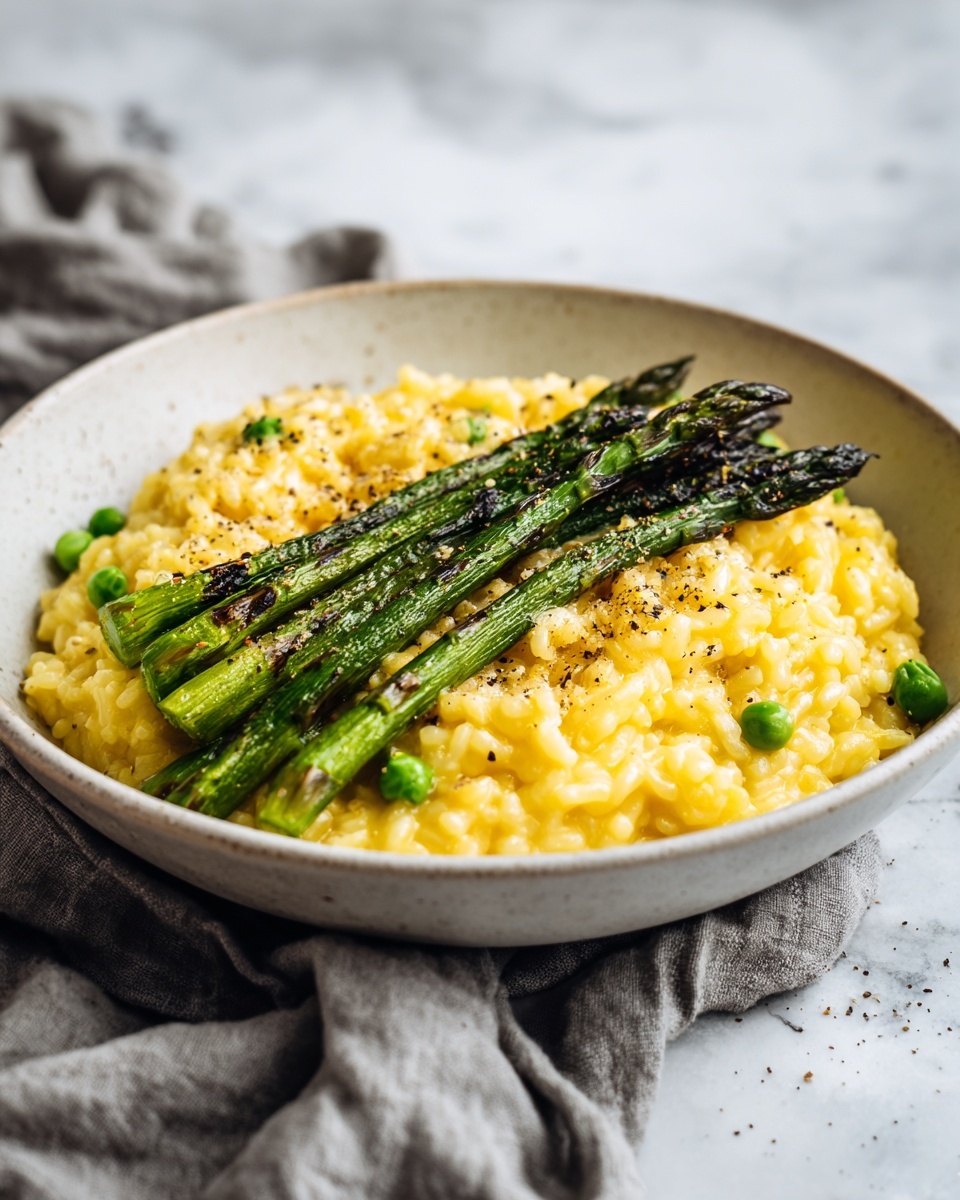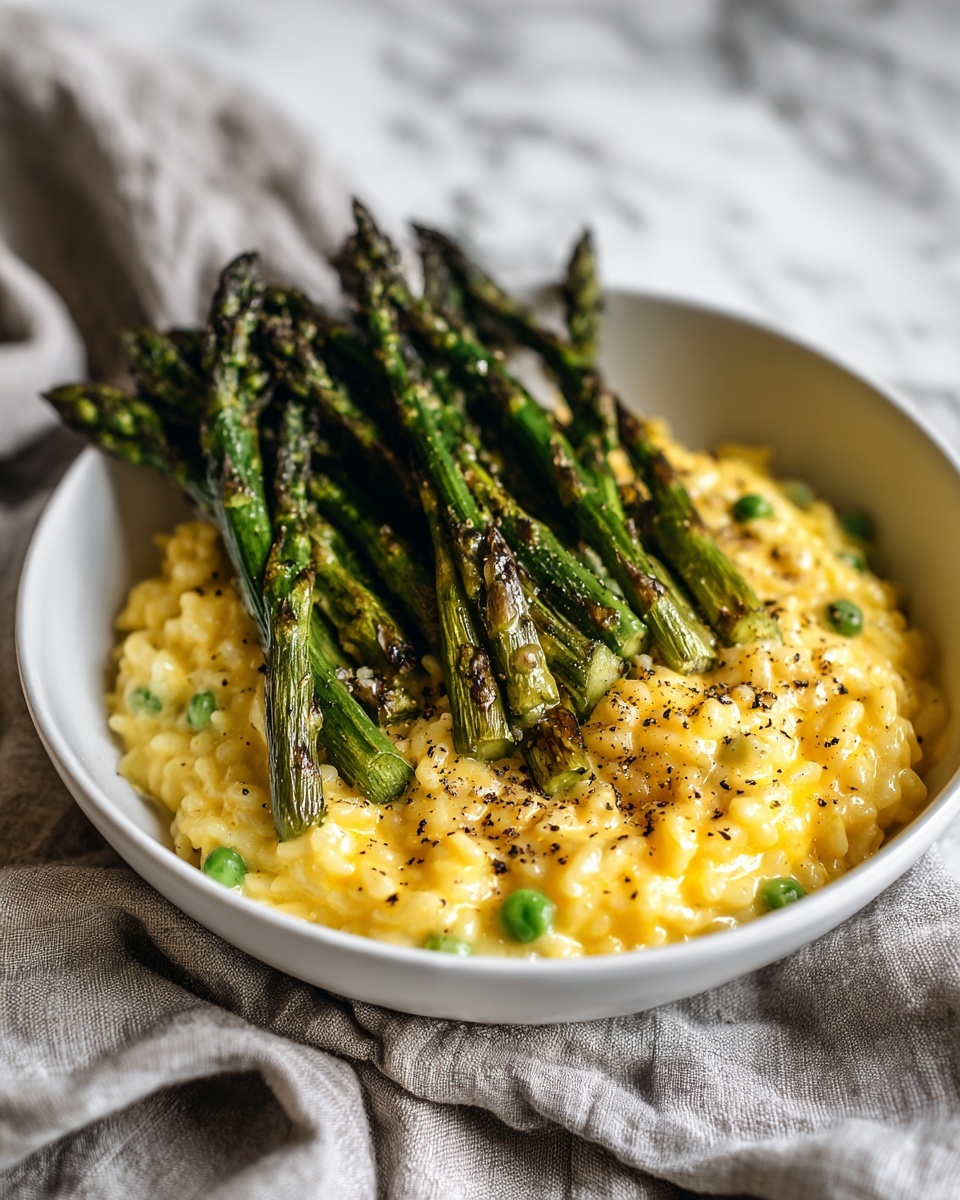There is something truly magical about a warm, creamy risotto that celebrates the freshness of spring, and this Spring Asparagus Risotto Recipe does just that with every bite. Featuring tender asparagus pieces, zesty lemon, and the velvety richness of Parmesan, this dish feels like springtime in Italy wrapped up in a bowl. Whether you’re cooking for a cozy night in or hosting friends, this risotto offers a comforting yet elegant flavor profile that’s bound to become a staple in your seasonal menu.

Ingredients You’ll Need
The beauty of this Spring Asparagus Risotto Recipe is in its simple, quality ingredients that come together to create layered flavors and delightful textures. Each element, from the creamy Arborio rice to the fresh asparagus and bright lemon, plays a crucial role in bringing balance and vibrancy to the dish.
- 1 cup Arborio rice: This short-grain rice is essential for that creamy, starchy texture unique to risotto.
- 1 tablespoon olive oil: Adds a subtle fruitiness and helps sauté the aromatics evenly.
- 1 tablespoon unsalted butter: Brings richness and smoothness to the risotto’s finish.
- 1 small onion (finely chopped): Provides a gentle sweetness that forms the flavor base.
- 2 garlic cloves (minced): Infuses subtle warmth and aromatic depth.
- ½ cup dry white wine: Introduces acidity and complexity that brighten the dish.
- 4 cups low-sodium vegetable broth (warmed): The cooking liquid that cooks the rice and carries flavor.
- 1 bunch asparagus (trimmed and cut into 1-inch pieces): Delivers fresh, crisp bursts of spring flavor and color.
- ½ cup grated Parmesan cheese: Adds umami richness and that signature cheesy finish.
- 1 tablespoon lemon juice: Injects a bright, fresh contrast to the creamy risotto.
- 1 teaspoon lemon zest: Provides aromatic citrus oils that enhance the overall flavor.
- Salt and black pepper to taste: Essential for seasoning and balancing the dish.
- Fresh herbs like parsley or chives for garnish (optional): A vibrant touch of greenery and freshness.
How to Make Spring Asparagus Risotto Recipe
Step 1: Sauté Aromatics
Start by heating the olive oil and butter in a large saucepan over medium heat. Adding the chopped onion first allows it to soften gently, releasing its natural sweetness—this is the foundation of your risotto’s flavor. After about 3 to 4 minutes, when the onion looks translucent, stir in the minced garlic and let it cook for just 30 seconds until fragrant, being careful not to burn it.
Step 2: Toast the Rice
Next, add the Arborio rice to the pan, stirring it around for 1 to 2 minutes. Toasting the rice like this might seem like a small step, but it helps each grain stay separate and allows it to absorb the liquids evenly—essential for that perfect creamy consistency.
Step 3: Deglaze with White Wine
Pour in the dry white wine and stir continuously until most of the liquid has been absorbed. This step adds brightness and a subtle acidity that balances the richness of the cheese and butter later on.
Step 4: Gradually Add Broth
This classic risotto technique involves adding warm vegetable broth one ladle at a time. Stir frequently and wait until the rice has absorbed each addition before adding the next. This patient process usually takes about 18 to 20 minutes and is what transforms the rice into its signature creamy yet toothsome texture.
Step 5: Incorporate Asparagus
When the rice is nearly done—about 5 minutes before finishing—stir in the asparagus pieces. Cooking them within the risotto allows them to become tender but still retain a pleasant snap, adding fresh texture and a gorgeous pop of green.
Step 6: Finish with Cheese and Lemon
Once the risotto is tender and creamy, remove it from the heat and gently fold in the Parmesan cheese, fresh lemon juice, and lemon zest. This finishing touch brings delicious umami and a vibrant zing that brighten the entire dish. Season with salt and pepper to taste, and let the risotto rest for a minute before serving.
How to Serve Spring Asparagus Risotto Recipe

Garnishes
Elevate your Spring Asparagus Risotto Recipe with fresh herbs like parsley or chives sprinkled on top. These not only add a fresh burst of color but also enhance the dish’s vibrant flavors, bringing a lively, aromatic finish.
Side Dishes
For a complete meal, pair this risotto with a crisp green salad dressed in lemon vinaigrette or roasted cherry tomatoes that echo the summery notes of the recipe. Grilled chicken or seared scallops also make fantastic companions by adding protein without overwhelming the delicate flavors.
Creative Ways to Present
Serve this risotto in rustic bowls to showcase its creamy texture, or for a more elegant touch, plate it with a twist of lemon zest and a sprig of herb on top. A light drizzle of extra virgin olive oil can also add shine and richness right before serving, making it picture-perfect and irresistible.
Make Ahead and Storage
Storing Leftovers
Spring Asparagus Risotto Recipe is best enjoyed fresh, but leftovers can be stored in an airtight container in the refrigerator for up to 2 days. The risotto may thicken, so just add a splash of broth or water when reheating to loosen it back up.
Freezing
Freezing risotto is not ideal because the texture tends to suffer and become mushy upon thawing. If you want to save leftovers, refrigerating is the preferred option to preserve its creamy consistency and flavor.
Reheating
To reheat your risotto, place it in a saucepan over low heat with a bit of warm broth or water. Stir gently and frequently, adding liquid as necessary until the risotto reaches its original creamy texture. Avoid microwaving if possible, as the texture may become uneven.
FAQs
Can I use regular rice instead of Arborio rice?
Arborio rice is specially suited for risotto because of its high starch content, which creates that creamy texture. Using regular long-grain rice won’t yield the same result and will likely be less creamy and more separate in texture.
What if I don’t have white wine on hand?
You can substitute the white wine with an equal amount of vegetable broth or a mild white grape juice mixed with a splash of vinegar to maintain some acidity. Keep in mind that wine adds complexity, so the flavor may be slightly different.
How do I keep the asparagus crisp and vibrant?
Adding the asparagus towards the last 5 minutes of cooking allows it to steam gently and retain its bright green color and tender-crisp texture. Cooking it too long can make it mushy and dull in color.
Can this recipe be made dairy-free?
Absolutely! Replace the Parmesan cheese with nutritional yeast to keep the cheesy depth without dairy. You might also want to use olive oil in place of butter to ensure it’s fully dairy-free.
Is it okay to add other vegetables?
Definitely. Peas or baby spinach are great additions that can be stirred in alongside the asparagus for extra color, texture, and nutritional goodness. Just add them near the end to avoid overcooking.
Final Thoughts
If you’re looking for a dish that feels both special and comforting, I can’t recommend this Spring Asparagus Risotto Recipe enough. Its creamy texture, fresh asparagus, and lemony brightness combine to create a truly memorable meal that’s perfect for welcoming the spring season. Give it a try—you might just find your new favorite way to celebrate seasonal flavors!
Print
Spring Asparagus Risotto Recipe
- Prep Time: 10 minutes
- Cook Time: 25 minutes
- Total Time: 35 minutes
- Yield: 4 servings
- Category: Main Course
- Method: Stovetop
- Cuisine: Italian
- Diet: Vegetarian
Description
This Spring Asparagus Risotto is a creamy, comforting Italian main course featuring tender Arborio rice cooked slowly with fresh asparagus, tangy lemon, and Parmesan cheese. Perfectly balanced with bright lemon zest and juice, and a subtle savory note from garlic and onion, this dish highlights the vibrant flavors of spring in a rich, satisfying meal.
Ingredients
Main Ingredients
- 1 cup Arborio rice
- 1 tablespoon olive oil
- 1 tablespoon unsalted butter
- 1 small onion, finely chopped
- 2 garlic cloves, minced
- ½ cup dry white wine
- 4 cups low-sodium vegetable broth, warmed
- 1 bunch asparagus, trimmed and cut into 1-inch pieces
- ½ cup grated Parmesan cheese
- 1 tablespoon lemon juice
- 1 teaspoon lemon zest
- Salt and black pepper, to taste
- Fresh herbs like parsley or chives for garnish (optional)
Instructions
- Prepare the base: Heat olive oil and butter in a large saucepan over medium heat. Add the finely chopped onion and cook until softened and translucent, about 3 to 4 minutes. Stir in minced garlic and cook for an additional 30 seconds until fragrant.
- Toast the rice: Add the Arborio rice to the pan and stir continuously for 1 to 2 minutes, allowing the grains to become lightly toasted but not browned.
- Deglaze with wine: Pour in the dry white wine and stir gently until it is mostly absorbed by the rice, imparting a subtle acidity and depth of flavor.
- Cook the risotto: Begin adding the warm vegetable broth, one ladleful at a time. Stir frequently and allow each addition of broth to be mostly absorbed before adding the next. Continue this gradual process for 18 to 20 minutes, stirring often to promote creamy starch release. The rice should be tender with a slight bite (al dente).
- Add asparagus: About 5 minutes before the risotto finishes cooking, stir in the trimmed and cut asparagus pieces. Continue cooking until the asparagus is tender-crisp and vibrant green.
- Finish and season: Remove the pan from heat and stir in grated Parmesan cheese, fresh lemon juice, and lemon zest. Season with salt and black pepper to taste.
- Rest and serve: Allow the risotto to rest for a minute to thicken slightly before serving. Garnish with fresh herbs such as parsley or chives if desired, and enjoy your bright, creamy spring risotto.
Notes
- For a dairy-free alternative, substitute Parmesan cheese with nutritional yeast to retain umami flavor.
- To add extra color and nutrition, peas or baby spinach can be incorporated alongside the asparagus during the last few minutes of cooking.








